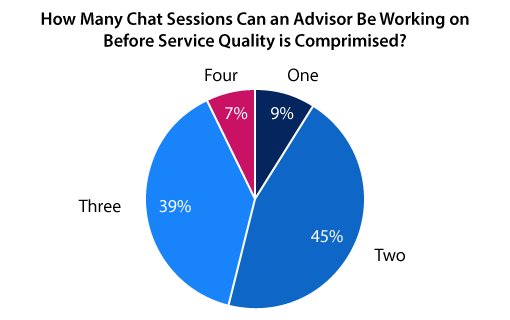More and more contact centres are implementing live chat. Yet many are making the same false assumptions and mistakes.
With this in mind, here are ten things that you should know (and “they” won’t tell you) before you install live chat in your contact centre.
1. It’s Probably No Cheaper Than a Phone Call
When live chat first became mainstream, the conventional wisdom was that contacts via the channel were cheaper than calls. This was because, although calls are generally half the length of live chat conversations, advisors could handle three contacts at a time.
However, our 2016 poll highlighted that more contact centres choose to give advisors two live chat sessions to handle at a time than those that give advisors three. This is highlighted below.

The results shown in this graph are based on the opinions of our readers. They were sourced from our webinar: Best Practices for Voice, Email and Webchat
So, why is this? Martin Hill-Wilson, Founder of Brainfood Extra, believes that such a level of multitasking could have a negative influence on quality.
Martin says: “If the task is simple, you can probably multitask, but I don’t think you can listen to a complicated customer problem on chat any more than you can on voice.”

Martin Hill-Wilson
“So there’s an interesting question here, which is: ‘How many chats can you actually handle, from the efficiency point of view, without customers beginning to go ‘you’re not hearing me properly’?’ When the customer thinks ‘I bet they’re talking to five people at a time’ the experience diminishes.”
The negative impact of too much multitasking may have been reflected in the mediocre quality results of our reader Allison’s live chat channel in her contact centre.
Allison told us: “Three is how many we currently deliver, but we do feel high quality is being compromised, so we are considering moving back to two.”
2. Average Handling Time (AHT) Goes up With Concurrency
A live chat is typically twice as long as a phone call, when you have a concurrency of two. However, as you increase concurrency, AHT increases further.
When live chat was first released in contact centres, it was marketed as a technical solution. This meant that technical contact centres would be asked questions like “what’s wrong with my PC?”, for example, and advisors would often use a “copy and paste” scripted response. In this case, the answer may have been as simple as “try a reboot”.
By simply having to answer in this scripted fashion, contact centres could handle a number of chats concurrently, without there being any real impact on handling times. Arguably, over time, this has created a lot of myths about the live chat channel.
One such myth is that there will be little impact on AHT if an advisor were to switch between concurrent chats. This may be true when using scripted responses, but in the interests of service quality, most contact centres tend not to use live chat scripts.
So, advisors generally make decisions based on their own intuition and “train of thought”. However, this “train of thought” is likely lost when they have to switch to a different conversation, meaning that they have to later re-engage with the conversation, which costs time.
Peter, one of our readers, has found that “at a high level, every 0.1 increase in concurrency (e.g. 1.3 chats to 1.4) equates to roughly a 30-second increase on chat AHT. The same increase in concurrency also sees an increase in occupancy.”
Opportunities to ease cost of serve have got to come from tackling demand failure, rather than thinking there’s such a thing as a cheaper channel.
Martin Hill-Wilson
When AHT goes up, there will likely be a negative impact on costings. This highlights again that, for most, the cost of live chat is not lower than a phone call.
Remember, as Martin-Hill Wilson puts it: “The cost of doing business in today’s world is a choice. So, opportunities to ease cost of serve have got to come from tackling demand failure, rather than thinking there’s such a thing as a cheaper channel.”
3. Customer Satisfaction Falls With More Than Two Concurrent Sessions
In our article “Live Chat Probably Costs More Than a Phone Call“, Wayne, one of our readers, says: “I’ve found satisfaction drops when you move from two to three chats in customer service at least, so it will nose dive with even more.”
Another reader told us: “The sweet spot for live chat seems to be 2.4 concurrent chats. Above this level, customer satisfaction drops off. Unfortunately, our chat software only allows us to set concurrency at two or three.”
So, there seems to a pattern that Customer Satisfaction (CSat) dips when an advisor handles more than two contacts at a time, especially if these contacts are more than just “transactional” contact types.
However, there are some contact centres that should even consider reducing that number to one, according to Paul Weald, Director at mcx.
If your advisors have to speak with vulnerable customers in sensitive situations, you only ever want to have one single session active.
Paul Weald
Paul says: “When Childline tried to encourage vulnerable people to communicate and get in touch, they recognised the importance of one-to-one conversations with vulnerable young people, in order to offer immediate and focused support.”
“This is a lesson that if your advisors have to speak with vulnerable customers in sensitive situations, you only ever want to have one single session active.”
4. Live Chat May Increase Overall Contact Volumes
The general consensus around the contact centre managers that we have spoken to is that the reasons for deploying live chat are not about saving money but about customer preferences.
By offering live chat to your customers, you open yourself up to a new demographic of people. This is a good thing, as customers who wouldn’t have got in touch before about minor issues may now choose to do so through live chat, enabling you to help them and secure future business. However, it will likely cause an increase in contact volumes.
The increase in contact volumes will probably be even larger if you represent a company which appeals to young customers, as millennials are the most likely to use the channel. However, we are all on a digital journey, we are just all at different stages. So, don’t design live chat with the purpose of solely impressing your younger customers.
In addition, with live chat, customers have more time to reply to advisors. This is because they don’t feel any time pressure to provide an immediate response, as they would on the phone. Customers can take their time and later come back with even more questions.
With this deliberation period, AHT becomes very unpredictable and difficult to forecast…
5. It’s Difficult to Forecast/Schedule
Creating forecasts and scheduling advisors has been tried and tested in the contact centre for years, with most using the Erlang C calculation. But tools such as the Erlang Calculator are not well adapted to concurrency.
Some people use Erlang for forecasting headcount but apply a concurrency factor to reduce the contact volume. This works to a point, but it is not very accurate.
Also, handling times will be much more varied on live chat, as customers do not feel the urge to respond right away. Therefore you cannot forecast using the Erlang distribution, as you would for calls.

Phil Anderson
So, when implementing the channel, Phil Anderson, Head of Practices (Planning) at The Forum, suggests: “Start with a small team and think about the operational hours that you want to cover. Then, limit the number of people who use live chat and get an idea of demand along the way.”
While this is one option, there are a number of WFM systems that can forecast concurrency and there are also simulations/Excel tools that claim to solve this problem.
However, Richard Abdy, also of The Forum, highlights another problem big businesses face when implementing live chat as a new channel.
One of the problems that big businesses find, every time they seek to open up a new channel, is that the CRM system sitting behind everything is not properly linked with it.
Richard says: “One of the problems that big businesses find, every time they seek to open up a new channel, is that the CRM system sitting behind everything is not properly linked with it.”
“So, it becomes very difficult to see what repeat contacts you are getting. This means that forecasting becomes even more difficult because you are losing the customer journey behind it.”
6. Live Chatbots Have Low Customer Satisfaction
Sanjeev, one of our readers, tells us: “We implemented chatbots, but the CSat score was only 35%, compared to the 90+% score for human advisors.”
While chatbots have some work to do before they can come anywhere close to human advisors in terms of satisfaction, there are some simple things that you can do to improve chatbot satisfaction.
For example, one straightforward tip might be to give your chatbot a name. A chatbot’s name is the first word that customers see when they start chatting, so you want it to bring the right associations to mind straight away. Think about Ernest, Facebook Messenger’s personal banking bot: what better name to inspire trust?
Another tip would be to avoid jargon and complex words in your chatbot scripts for live chat. Having jargon that customers may not understand in your bot script may escalate the contact to an advisor – removing the point of having a bot in the first place.
For more tips like this, read our article: Ten Tips for Giving Your Chatbot a Human Voice
7. You Can Use Emojis – But Only if the Customer Does First
Emojis are a divisive part of live chat conversations. Some people love them and some people hate them, so they can really impact CSat scores on live chat (as well as email).
When making the decision on whether to use them or not, Neil Martin, Creative Director at The First Word, advises us to: “Think about the customer, what do they want? And, you’ve got to think about your brand, is it right for your brand?”
If your customers are using them it’s good to use them back, particularly in positive scenarios where something good has happened. This is because if you don’t use them it could look a little bit ‘cold’.
Neil Martin

Neil Martin
“My view on it is that if your customers are using them it’s good to use them back, particularly in positive scenarios where something good has happened. This is because if you don’t use them it could look a little bit ‘cold’.”
“However, don’t go mad with them, and if you’re in a serious discussion or something bad has happened, I’d avoid them.”
Neil stresses that these are just “general tips”, as it is down to the individual advisor to decide what’s right for the customer. This highlights how emotional intelligence is a key advisor quality.
For more live chat tips from Neil, read our article: 10 Best Practices to Improve Live Chat
8. Don’t Have the Icon if You Can’t Meet Demand
One of the benefits of live chat is that it’s relatively straightforward to direct customers to other channels when the demand gets too high. This is because you can control when live chat becomes available.
However, whether using this tactic is in the best interests of your customers and Resource Planning Team is an interesting debate, according to Phil Anderson.
Phil says: “If you limit live chat and your customers aren’t aware it’s there all the time, it can be difficult to understand your true demand. However, if you have the channel there all of the time, it becomes much easier to forecast.”
If you limit live chat and your customers aren’t aware it’s there all the time, it can be difficult to understand your true demand.
Phil Anderson
Customers may also be disappointed to be unable to contact you via their preferred channel. But in times when live chat demand is high, ask yourself: is the disappointment better than making the customer wait an age for a response?
Also, live chat can be useful to spread demand across the centre. So when call volumes are high, really promote the live chat option on the website, perhaps through pop-ups. Hopefully, this will take some of the pressure off advisors on the voice channel.
9. Live Chat Cannot Have the Same Proposition as the Phone
The attraction of chat is that interactions can be short, sharp and timely. However, not all call types fit this criteria well.
Making this point, Paul Weald said: “I once knew of an energy company which had a live chat team with a proposition that said ‘customers can do exactly the same business processes by a chat as they can do by phone’.”

Paul Weald
“So we had several chats for meter readings, billing changes and other enquiries that were lasting over an hour, because it just wasn’t effective to try and do identification, verification and other similar processes.”
“I asked the team how long the equivalent telephone transaction would take and the answer was five minutes. So, even though they were dealing with multiple chats, the economics didn’t work and it didn’t seem to work from a customer perspective either.”
This raises the question: is there a time to move a contact from one channel to another? Say after 20 minutes, for example?
Apparently not, as according to Paul: “It is more likely down to the type of enquiry, rather than a time.”
If the advisor realises that they need to go through an ID process, they could ask the customer to switch channel. And if the customer can come back and say “I’d prefer not to”, advisors should ideally be aware of the most efficient way of completing a transaction.
10. Extend Opening Hours for Live Chat
There seems to be a convention in many contact centres which dictates that when the phone lines close, every other channel must close also. But extending opening hours for live chat can lead to good results.
Vax’s contact centre in Droitwich closes phone lines at 5pm, while advisors don’t finish their shifts until 5:30pm. This is because their live chat channel doesn’t close until this later time.
By keeping this final half an hour just for live chats, the whole team can help any remaining customers on the channel, while enjoying a more relaxed end to the day. This also helps to ensure that advisors don’t rush through calls at the end of their shifts.
While most of the team will be handling live chats in this last 30 minutes, the extra time will also allow more time for senior members (as well as a couple of advisors perhaps) to create a shift report. This report will ideally cover areas for improvement and other key observations.
For more information and best practices on the topic of live chat, read our articles:
- How to Assess Quality on Email and Live Chat in the Contact Centre
- 15 Golden Rules of Webchat
- Training Your Staff to Be Effective at Live Chat
Author: Robyn Coppell
Published On: 15th Aug 2018 - Last modified: 29th Apr 2024
Read more about - Technology, Average Handling Time (AHT), Customer Satisfaction (CSAT), Editor's Picks, Forecasting, Live Chat, Martin Hill-Wilson, Paul Weald, Phil Anderson, Richard Abdy, The Forum




































